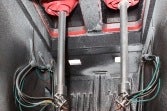
Wheelabrator has extended its successful Module8 concept for a new generation of wet blast machines.
The new wet blast Turntable machine (TTW5) has been developed from experience gained with the Module8 flexible machine concept. The machine delivers great performance and has two huge advantages compared to classical wet blast machines; the Module8 construction does not need any special foundations or a platform, and it is the same size and shares the same footprint as similar dry blast machines.
Installation is easy as user interfaces and operational controls are familiar to the operator, and you also enjoy the other benefits of the eight Module8 principles: flexibility, reduced wear, ease of maintenance, safety, productivity reliability, process reliability, quality and short delivery times.These were the reasons why one aerospace customer in particular placed an order for this machine.
The Module8 concept was developed from detailed analysis of customer requirements over a long period. The adaptable blast cabinet is created using flexible, modular wall and ceiling elements. Further components for blast media circulation and blasting technology are positioned around the cabinet so that they can be easily and safely maintained from only one level – preferably the accessible roof. Due to the modular construction, blast nozzles, workpiece transport devices and other systems can be installed on either side of the blast cabinet to create an optimised solution for each customer.
Module8 wet blast machines for aerospace components
The new machine is equipped with four blast nozzles which can be moved by two nozzle manipulators, each with five interpolating axes. Nozzle movements and the turntable allow an 11-axis process so that parts with complex geometries can be optimally blasted. Example applications include aerospace blades and blisks.
Blades are used in the front part of the engines with a length of up to 2m; they must have an extremely high stability and a good surface finish to deliver the required mechanical and aero dynamical properties. Blisks are used in the compressors of the engines, a special feature where a ring with blades forms one unit. It is most important for the aerodynamics of both products, that beside a precise and clean surface finish, the material must have a very high quality and stability at the welding seams. These characteristics can be delivered by the wet peening process using ceramic beads. The peening process will also provide improved protection against against corrosion.
The flexibility of the new wet blast turntable machine makes it ideal for blades and blisks. Long blades need a high blast cabinet to provide uniform treatment over the complete height. However, the blisks, with the relatively close arrangement of the blades, need a solution which allows precise treatment between the blades. This is feasible with the 11-axis process and the optional use of fine blast lances based on the flexible Module8 concept.
The customer also liked the flexibility of the design concept, the adaptability to new applications is possible as machine parts can easily be replaced and upgraded to meet future expectations.
Familiar machine structure and controls simplify integration
The processing of the parts is completely CNC controlled, including media flow and air pressure, to ensure that the customer’s clearly defined blast result is achieved. The Module8 machine structure and control is identical to the relevant Wheelabrator dry blast machines, so operators will recognise the familiar part holders, user interface and processes.
All the advantages of the Module8 concept are now available for wet blasting technology. For flexibility, reduced wear, ease of maintenance, safety, productivity reliability, process reliability, quality and short delivery times, ask Wheelabrator about Module8.










